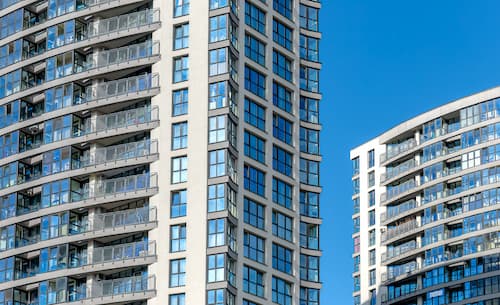- Condo insurance coverage: What does an HO‑6 policy include?
- What does your HOA’s master policy cover?
- What perils are covered by condo insurance?
- How much condo insurance do you need?
- Do lenders require condo insurance?
- Things to consider before buying HO-6 insurance
- How to buy condo insurance
- Best practices for choosing condo insurance
- FAQ: Condo insurance coverage
Condo insurance coverage: What does an HO‑6 policy include?
An HO-6 condo insurance policy covers the following:
- Building property (dwelling)
- Personal property (contents)
- Personal liability
- Loss assessment
- Master policy deductible
- Loss of use (additional living expenses)
- Medical payments
All of these coverages are much the same across HO-6 policies, except building property coverage. How much building property coverage you need and what is covered depends on the HOA policy.
We’ll take a detailed look at each of the parts of a condo policy and what they cover below.
Building property coverage
Also called dwelling coverage, this covers the parts of the interior of the unit for which you’re responsible. Dwelling coverage is the main difference between condo and homeowners insurance. What you need to cover will depend on what’s not covered by your HOA master policy.
It’s vital to read your master policy carefully to know how much dwelling coverage you need for your condo. You may not need building property coverage if your master policy covers all parts of your unit that aren’t your personal property. On the other hand, you may need dwelling coverage for everything from the walls in.
Building property coverage protects things like:
- Light fixtures
- Countertops
- Bathroom fixtures
- Built-in appliances
- Doors
- Cabinets
Personal property coverage
Personal property coverage, also called contents coverage, applies to everything in your unit that is not a fixture. This means electronics, toys, furniture, décor, clothing, books, kitchen equipment and anything else you own. Like homeowners insurance, HO-6 personal property coverage applies to your belongings at home and outside your home on a more limited basis.
Off-premises coverage for damaged or stolen items is limited to a percentage of your total personal property coverage, usually 10%.
HO-6 coverage for personal property is a flat amount that you will need to calculate. Make sure you have included all of your possessions, from kitchen gadgets to bathroom towels, in your calculation.
There are two types of personal property coverage: replacement cost and actual cash value. Replacement cost pays the actual cost to replace each item at today’s prices. On the other hand, actual cash value will only pay the item's depreciated value. Adding replacement cost coverage is always a good idea, as items depreciate quickly.
Note that special limits exist on high-value items like jewelry, art, or musical instruments. You can add additional coverage for these items or add what’s known as a floater or a rider. Scheduled property floaters insure specific items for their appraised value.
Personal liability coverage
Your HOA's liability insurance only applies if a visitor or resident is injured in the project's common areas – like elevators, pathways, swimming pools, and clubhouses. Personal liability insurance provided by an HO-6 policy protects you and covered household members when you're responsible for bodily injury or property damage to others.
In addition to paying settlements to injured parties, HO-6 insurance covers the cost of defending you from lawsuits. It works both in your home and off the condo premises.
Condo liability coverage limits typically run between $100,000 and $500,000. How much liability insurance do you need for a condo? Experts offer a few ways to calculate it.
One is taking the value of your assets plus five times your annual income – you're protecting everything you own plus your future income. You can purchase a personal umbrella (excess liability) policy for more protection.
In many cases, you must have at least $300,000 in liability coverage on the underlying policy before insurers will sell you an umbrella policy. Some companies will require that you carry the maximum available, which is a good idea if you need extra liability.
Loss assessment coverage
Loss assessment coverage kicks in when a covered peril causes an assessment -- for example, a huge storm destroys the roof of the entire building, exceeding the HOA's insurance limits and sticking your community with a giant repair bill. Every condo owner is responsible for a share of the cost, and loss assessment coverage will kick in to help pay your part.
Experts recommend at least $50,000 of coverage, while the standard HO-6 comes with much less – often just $1,000. Note that this coverage only applies to covered perils. If the assessment results from an earthquake, and there is no earthquake insurance in force, you won't be protected.
Master policy deductible coverage
HOAs increasingly choose higher deductibles for their master policies, reducing their premiums while upping the risk to individual owners. Industry insiders have noted that deductibles over $10,000 are not rare, and for some complexes have climbed as high as $50,000.
Master policy deductible coverage reimburses unit owners for these deductibles. You should ensure this coverage equals your master policy deductible to avoid unexpected losses. By reading the policy carefully, you'll better understand how you’ll be reimbursed.
Additional living expenses or loss of use coverage
Loss of use coverage kicks in when your unit becomes uninhabitable due to a covered event. During repairs, this coverage will pay for things like a hotel room, food and other costs incurred while you can’t be in your home.
Medical payments
Medical payments coverage pays for medical costs if someone is hurt at your home. For example, if a friend slips on your rug and breaks an ankle, your medical payments insurance can cover the ER bill. This is usually between $1,000 and $5,000 and is designed to cover smaller medical bills.
People ask
Does an HO-6 cover the master policy deductible?
Yes, an HO-6 will generally cover your portion of the master policy deductible when a claim is filed and the cost is shared between the condo owners.
What does your HOA’s master policy cover?
The condominium master policy doesn’t have a lot of requirements, and coverage can vary. HOA coverage must address just two basic items:
- General liability for the association
- Property damage coverage for the common areas
In addition to the basics, HOAs can add:
- Personal liability insurance for board members
- Coverage for damage related to sewer and drain backups
- Insurance against theft of HOA funds
| Coverage type | What the HOA policy covers | What your policy covers |
|---|---|---|
| Bare walls | - The exterior structure of the building and common areas - Fixtures and furnishings for collective use Example: outdoor light fixtures, gutters | - Everything from the walls in - All fixtures and furnishings for your exclusive use - Upgrades and improvements you make -Personal property Example: countertops, interior light fixtures, appliances |
| Single entity | - The exterior structure of the building and common - areas - Fixtures in units Example: faucets, light fixtures inside and out | - Upgrades and improvements - Personal property Example: furniture, upgraded granite countertops |
| All-in/All-inclusive | - The exterior structure of the building and common areas - Fixtures inside the unit - Upgrades made by you or previous owners Example: Flooring, countertops, cabinets, light fixtures | - Your personal property Example: furniture, linens, electronics |
Additionally, all HO-6 policies, regardless of the HOA policy, provide you with:
- Personal liability coverage
- Loss of use/additional living expenses coverage
What perils are covered by condo insurance?
Most condo policies are open perils, which means they cover damage from all perils with the exception of those that are specifically excluded. Common covered perils include:
- Fire
- Theft
- Vandalism
- Storms and lightning
- Falling objects
- Water damage from sudden and accidental discharge
Check your policy for specifics.
What's not covered by condo insurance?
Perils excluded under a standard condo insurance policy include damage from floods, earthquakes, sewer backups, and (in some locales) hurricanes. Coverage for these can be purchased either as an endorsement or as a separate policy.
- Earthquakes. A standard condo policy excludes damage caused by earthquakes, but it can be added as an endorsement. In California, you can purchase earthquake coverage through the California Earthquake Authority.
- Floods. If your condo is in a Special Flood Hazard Area (SFHA), and you have a mortgage, you’ll be required to have flood insurance on your unit. However, even if you’re not required to have flood insurance, you might want the extra protection. The National Flood Insurance Program says that homeowners outside high-risk areas file over 25% of NFIP claims and receive one-third of flood disaster assistance.
- Windstorms and hurricanes (in some cases). Coverage for wind and hurricane damage is included in most HO-6 policies, but it can differ depending on the area in which you live. You may be able to exclude this coverage for a lower insurance rate, but it’s risky. In some areas, a separate policy or endorsement is required to cover wind or hurricane damage.
- Sewer backups. You can add sewer backup coverage to your policy as an endorsement, even if your HOA does not have this coverage. It will protect your personal property and building property as well.
How much condo insurance do you need?
You need enough condo insurance coverage to cover everything the HOA policy doesn’t. Here’s how to pick each coverage.
- Building property (dwelling) coverage. The coverage you need here depends on the type of policy the HOA has. A bare walls HOA policy will require you to buy the most coverage for the unit’s interior. A common method of estimating is to use 20% of the unit’s value, but you can also have it appraised.
- Personal liability coverage. A standard policy includes $100,000, but it costs very little to triple that amount to $300,000, and it’s highly recommended. Depending on your assets, you may need even more.
- Personal property coverage. Create a home inventory to calculate the value of your personal property. It’s always good to overestimate here and to upgrade your coverage to replacement cost.
- Loss assessment coverage. Your policy may include a minimal amount; consider increasing it to match your HOA deductible amount.
- Additional coverage. Consider flood insurance, earthquake insurance, water and sewer backup coverage and scheduled personal property coverage for high-value items like jewelry, all depending on your needs and the risks in your area.
Do lenders require condo insurance?
Yes, most lenders require insurance on your condo. Until recently, mortgage lenders did not require condo owners to carry insurance as long as there was an HOA master policy in place, but that has changed.
Requiring borrowers to insure their condo units reduces the risk of financial ruin for them and mortgage default for their lenders.
Fannie Mae, which buys the majority of non-government mortgages in the U.S., requires HO-6 insurance "covering personal property, personal liability, and the physical unit from the studs in, unless the lender can document that the association's master policy provides the same interior unit coverage." The minimum coverage allowed is 20% of the unit's appraised value, with a maximum 5% deductible. If you buy a $200,000 condo, then, you need at least $40,000 of insurance with a maximum $2,000 deductible.
HO-6 coverage is also required for FHA and VA home loans when the master policy does not include interior unit coverage.
Things to consider before buying HO-6 insurance
Insuring a condo is often trickier than protecting a single-family home. Knowing the types of HO-6 insurance and what they cover can help you figure out how much HO-6 insurance to buy. For more details, refer to our condo insurance guide.
“It can be quite confusing — even to people in the industry,” says Powell. “Despite the challenges, buying condo insurance can be simplified by using this checklist”:
- Check your master policy. Find out if it’s all-in, bare walls, or single entity. This will determine the type of coverage you need. You should also review:
- The HOA deductible
- Loss assessment information
- Exclusions on the HOA policy
- Choose your building property coverage. Based on the HOA policy, choose the amount of building property, or dwelling, coverage you need.
- Calculate the value of your personal property. Create a home inventory for a bse value, then consider:
- Floaters to provide additional coverage for specific items
- Upgrading to replacement cost coverage
- Determine your liability coverage needed. If you have a lot of assets, you need more liability coverage.
How to buy condo insurance
Buying condo insurance isn’t difficult; once you know what kind of coverage you need, you can start requesting quotes. Follow these steps:
- Gather multiple quotes. The more quotes you compare, the more likely you are to get the best deal. Aim for three to five quotes.
- Compare the coverage. Rates are not the only factor to consider. Compare what’s covered; some insurance companies include extras at no additional charge, so it’s important to factor those perks into your choice.
- Compare the companies. Take the time to see which companies have the best reputation for customer service and claims. Begin with our list of the best condo insurance companies.
Best practices for choosing condo insurance
Selecting the right condo insurance policy involves more than just finding the lowest price. Considerations such as coverage adequacy, location-specific risks, and potential gaps in your condo association's master policy should all be factored in.
To optimize your insurance costs, look for a policy that offers comprehensive coverage while also being mindful of your budget. Opting for a higher deductible can lower your premiums, but ensure you can pay any out-of-pocket expenses in case of a claim. Additional coverage options like flood insurance or earthquake insurance may also be necessary depending on where you live.
Ultimately, finding the right condo insurance policy requires thorough research, understanding your coverage needs, and working closely with a trusted insurance agent. By taking these steps, you can secure the protection you need for your condo and personal belongings at an affordable price.
FAQ: Condo insurance coverage
Is condo insurance required?
Although not required by law, condo insurance is likely required by your mortgage company.
Is HO-6 insurance worth it?
Regardless of the amount of coverage you choose to purchase, condominium insurance is a good investment. And, in some cases, it may be a requirement. Owning a condo is one of the largest investments you'll make in your lifetime, so make sure to protect it.
How much is condo insurance?
The average condo insurance cost is $746 a year. That’s for $60,000 in personal property coverage, $300,000 in liability, and a $1,000 deductible. If you need more or less coverage, your rates will vary.




